Occupational Health and Toxicology in Pharmaceutical Industry Report
VerifiedAdded on 2022/08/21
|13
|3022
|12
Report
AI Summary
This report investigates occupational health and toxicology, particularly within the pharmaceutical industry. It examines the impact of workplace hazards and toxin exposure on worker health. The report begins with an abstract and table of contents, followed by an introduction that defines key terms like occupational toxicology and its relevance to health risks. A comprehensive literature review explores existing research on the topic, discussing various hazards such as heavy metals, solvents, and asbestos, along with their effects on workers. The methodology section details the research design, which is quantitative, and explains the data instrument (surveys) and collection tools. It outlines the data analysis plan, including graphical analysis using MS Excel. Ethical considerations, such as informed consent and beneficence, are also addressed. The report concludes by summarizing the findings and emphasizing the need for understanding environmental resources and health-related toxicity to ensure worker safety. The report highlights the importance of risk assessment and interventions to reduce toxicity levels and promote public awareness of health risks associated with biological and chemical agents.
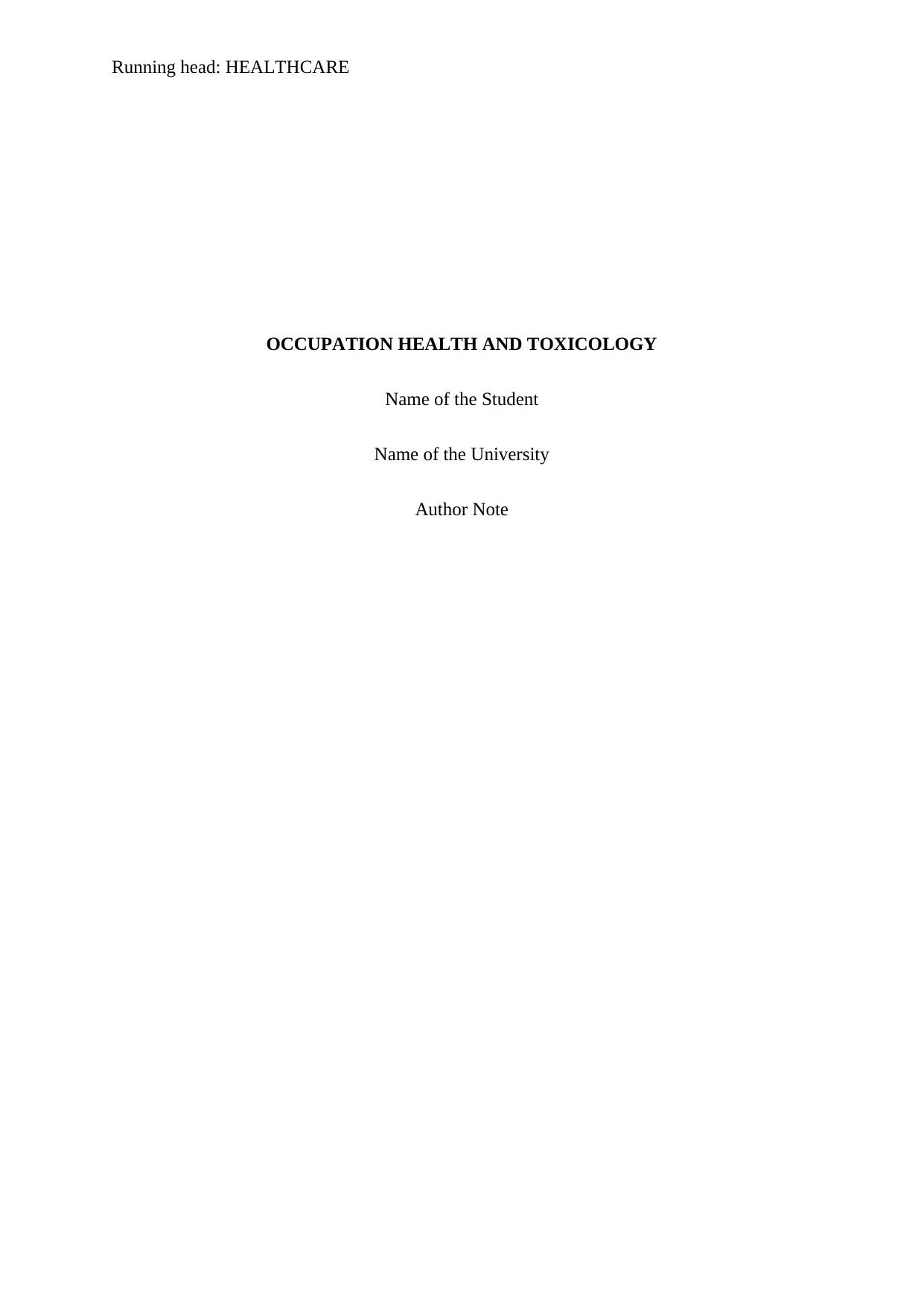
Running head: HEALTHCARE
OCCUPATION HEALTH AND TOXICOLOGY
Name of the Student
Name of the University
Author Note
OCCUPATION HEALTH AND TOXICOLOGY
Name of the Student
Name of the University
Author Note
Paraphrase This Document
Need a fresh take? Get an instant paraphrase of this document with our AI Paraphraser
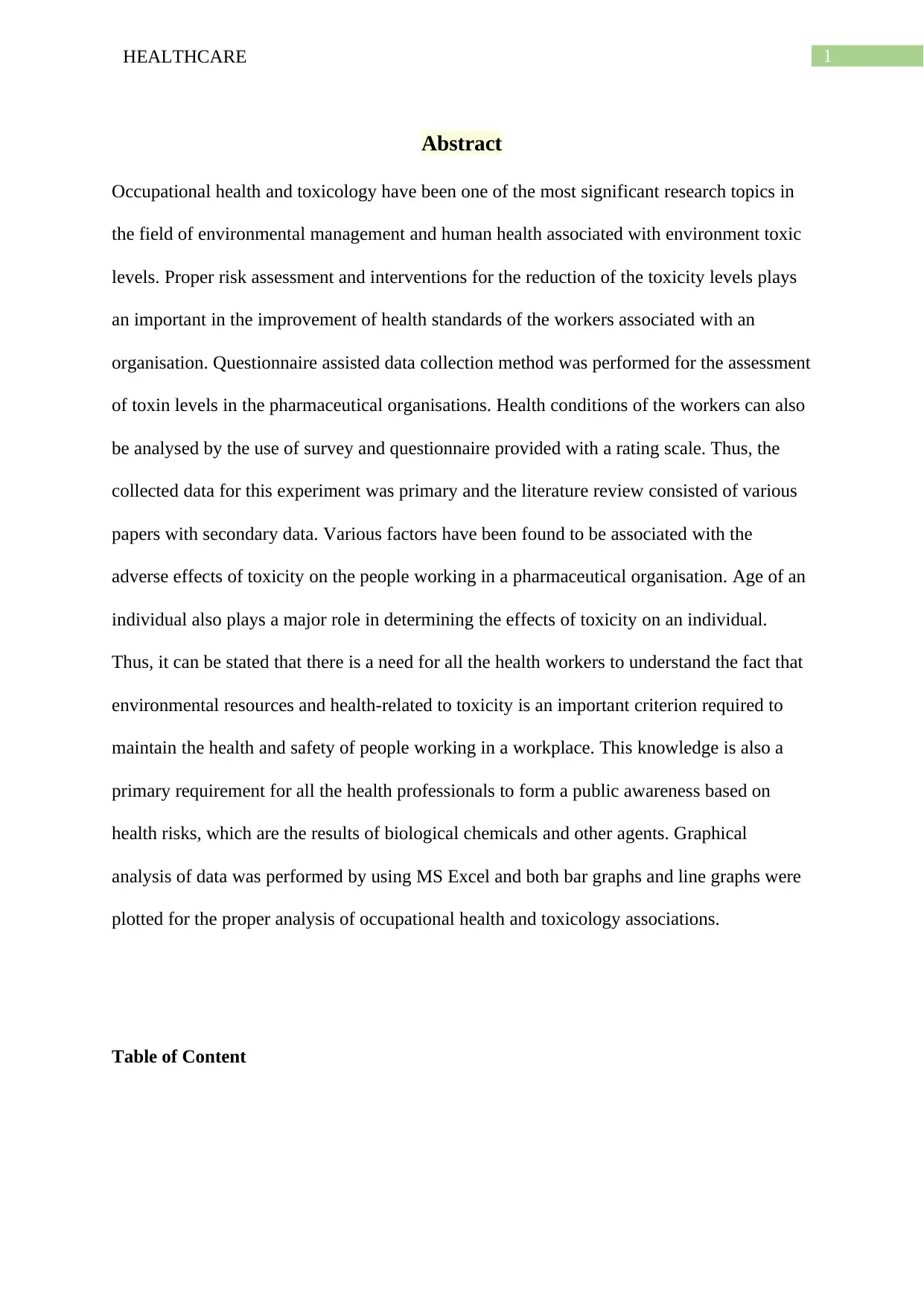
1HEALTHCARE
Abstract
Occupational health and toxicology have been one of the most significant research topics in
the field of environmental management and human health associated with environment toxic
levels. Proper risk assessment and interventions for the reduction of the toxicity levels plays
an important in the improvement of health standards of the workers associated with an
organisation. Questionnaire assisted data collection method was performed for the assessment
of toxin levels in the pharmaceutical organisations. Health conditions of the workers can also
be analysed by the use of survey and questionnaire provided with a rating scale. Thus, the
collected data for this experiment was primary and the literature review consisted of various
papers with secondary data. Various factors have been found to be associated with the
adverse effects of toxicity on the people working in a pharmaceutical organisation. Age of an
individual also plays a major role in determining the effects of toxicity on an individual.
Thus, it can be stated that there is a need for all the health workers to understand the fact that
environmental resources and health-related to toxicity is an important criterion required to
maintain the health and safety of people working in a workplace. This knowledge is also a
primary requirement for all the health professionals to form a public awareness based on
health risks, which are the results of biological chemicals and other agents. Graphical
analysis of data was performed by using MS Excel and both bar graphs and line graphs were
plotted for the proper analysis of occupational health and toxicology associations.
Table of Content
Abstract
Occupational health and toxicology have been one of the most significant research topics in
the field of environmental management and human health associated with environment toxic
levels. Proper risk assessment and interventions for the reduction of the toxicity levels plays
an important in the improvement of health standards of the workers associated with an
organisation. Questionnaire assisted data collection method was performed for the assessment
of toxin levels in the pharmaceutical organisations. Health conditions of the workers can also
be analysed by the use of survey and questionnaire provided with a rating scale. Thus, the
collected data for this experiment was primary and the literature review consisted of various
papers with secondary data. Various factors have been found to be associated with the
adverse effects of toxicity on the people working in a pharmaceutical organisation. Age of an
individual also plays a major role in determining the effects of toxicity on an individual.
Thus, it can be stated that there is a need for all the health workers to understand the fact that
environmental resources and health-related to toxicity is an important criterion required to
maintain the health and safety of people working in a workplace. This knowledge is also a
primary requirement for all the health professionals to form a public awareness based on
health risks, which are the results of biological chemicals and other agents. Graphical
analysis of data was performed by using MS Excel and both bar graphs and line graphs were
plotted for the proper analysis of occupational health and toxicology associations.
Table of Content
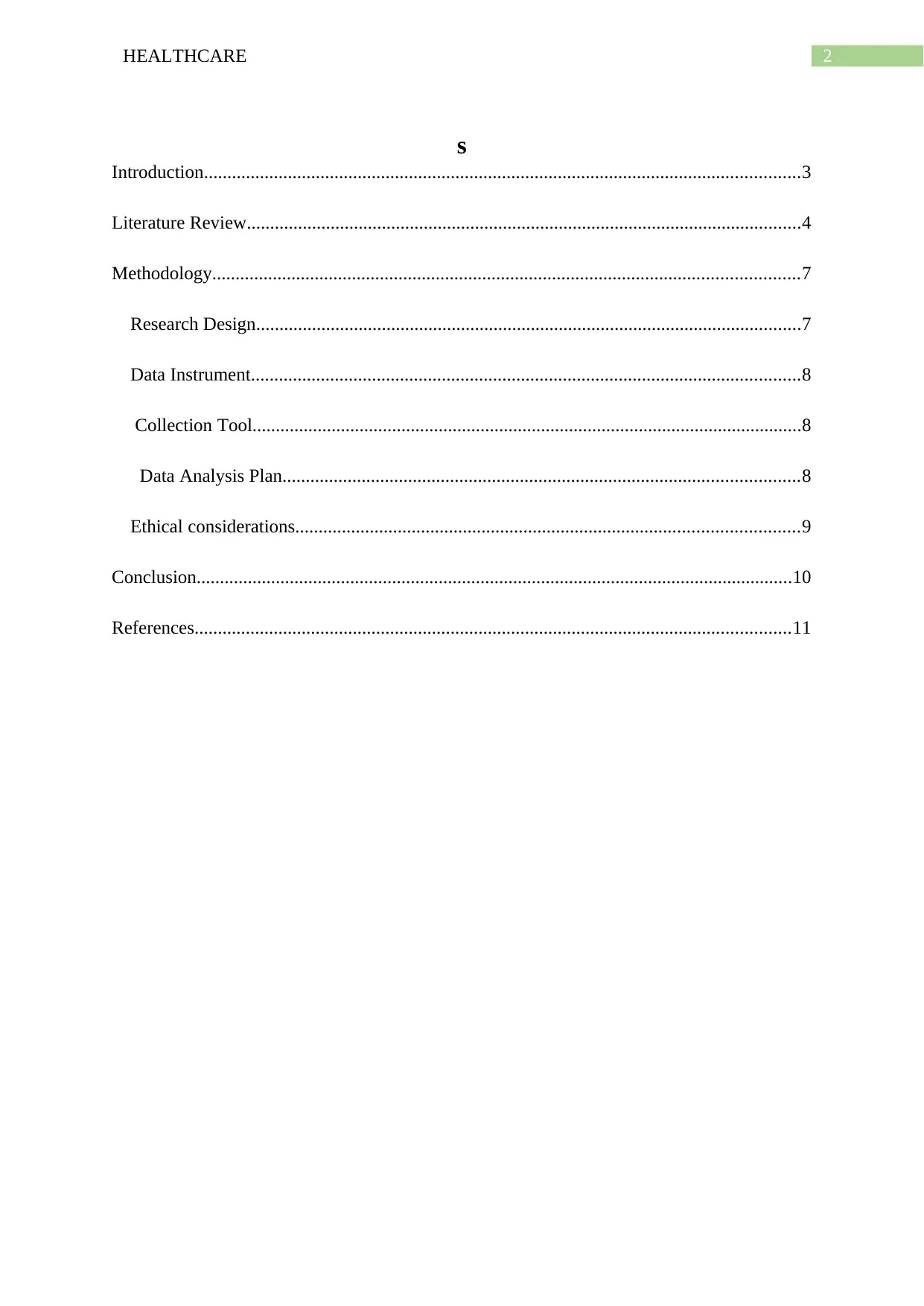
2HEALTHCARE
s
Introduction................................................................................................................................3
Literature Review.......................................................................................................................4
Methodology..............................................................................................................................7
Research Design.....................................................................................................................7
Data Instrument......................................................................................................................8
Collection Tool......................................................................................................................8
Data Analysis Plan...............................................................................................................8
Ethical considerations............................................................................................................9
Conclusion................................................................................................................................10
References................................................................................................................................11
s
Introduction................................................................................................................................3
Literature Review.......................................................................................................................4
Methodology..............................................................................................................................7
Research Design.....................................................................................................................7
Data Instrument......................................................................................................................8
Collection Tool......................................................................................................................8
Data Analysis Plan...............................................................................................................8
Ethical considerations............................................................................................................9
Conclusion................................................................................................................................10
References................................................................................................................................11
⊘ This is a preview!⊘
Do you want full access?
Subscribe today to unlock all pages.

Trusted by 1+ million students worldwide
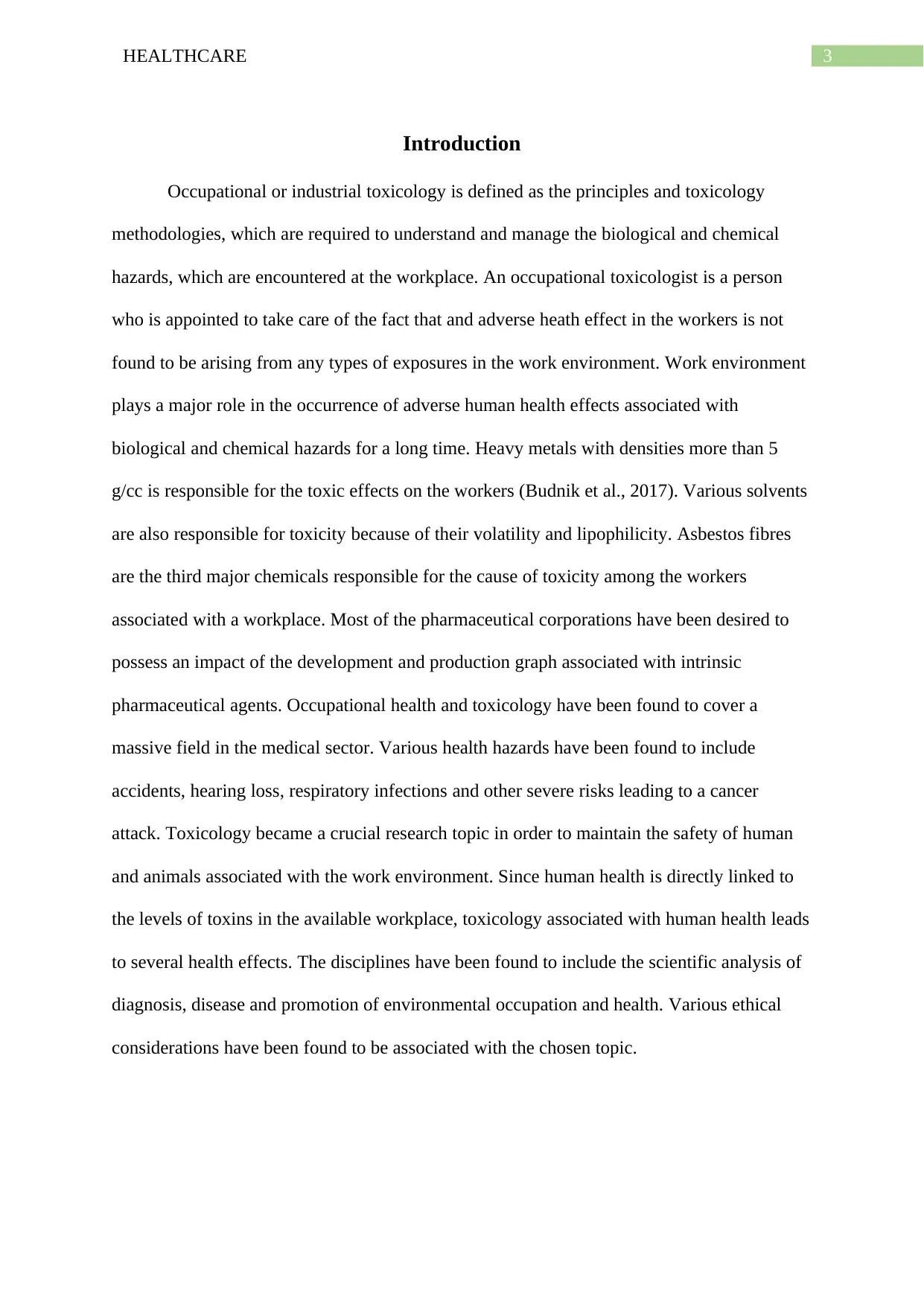
3HEALTHCARE
Introduction
Occupational or industrial toxicology is defined as the principles and toxicology
methodologies, which are required to understand and manage the biological and chemical
hazards, which are encountered at the workplace. An occupational toxicologist is a person
who is appointed to take care of the fact that and adverse heath effect in the workers is not
found to be arising from any types of exposures in the work environment. Work environment
plays a major role in the occurrence of adverse human health effects associated with
biological and chemical hazards for a long time. Heavy metals with densities more than 5
g/cc is responsible for the toxic effects on the workers (Budnik et al., 2017). Various solvents
are also responsible for toxicity because of their volatility and lipophilicity. Asbestos fibres
are the third major chemicals responsible for the cause of toxicity among the workers
associated with a workplace. Most of the pharmaceutical corporations have been desired to
possess an impact of the development and production graph associated with intrinsic
pharmaceutical agents. Occupational health and toxicology have been found to cover a
massive field in the medical sector. Various health hazards have been found to include
accidents, hearing loss, respiratory infections and other severe risks leading to a cancer
attack. Toxicology became a crucial research topic in order to maintain the safety of human
and animals associated with the work environment. Since human health is directly linked to
the levels of toxins in the available workplace, toxicology associated with human health leads
to several health effects. The disciplines have been found to include the scientific analysis of
diagnosis, disease and promotion of environmental occupation and health. Various ethical
considerations have been found to be associated with the chosen topic.
Introduction
Occupational or industrial toxicology is defined as the principles and toxicology
methodologies, which are required to understand and manage the biological and chemical
hazards, which are encountered at the workplace. An occupational toxicologist is a person
who is appointed to take care of the fact that and adverse heath effect in the workers is not
found to be arising from any types of exposures in the work environment. Work environment
plays a major role in the occurrence of adverse human health effects associated with
biological and chemical hazards for a long time. Heavy metals with densities more than 5
g/cc is responsible for the toxic effects on the workers (Budnik et al., 2017). Various solvents
are also responsible for toxicity because of their volatility and lipophilicity. Asbestos fibres
are the third major chemicals responsible for the cause of toxicity among the workers
associated with a workplace. Most of the pharmaceutical corporations have been desired to
possess an impact of the development and production graph associated with intrinsic
pharmaceutical agents. Occupational health and toxicology have been found to cover a
massive field in the medical sector. Various health hazards have been found to include
accidents, hearing loss, respiratory infections and other severe risks leading to a cancer
attack. Toxicology became a crucial research topic in order to maintain the safety of human
and animals associated with the work environment. Since human health is directly linked to
the levels of toxins in the available workplace, toxicology associated with human health leads
to several health effects. The disciplines have been found to include the scientific analysis of
diagnosis, disease and promotion of environmental occupation and health. Various ethical
considerations have been found to be associated with the chosen topic.
Paraphrase This Document
Need a fresh take? Get an instant paraphrase of this document with our AI Paraphraser
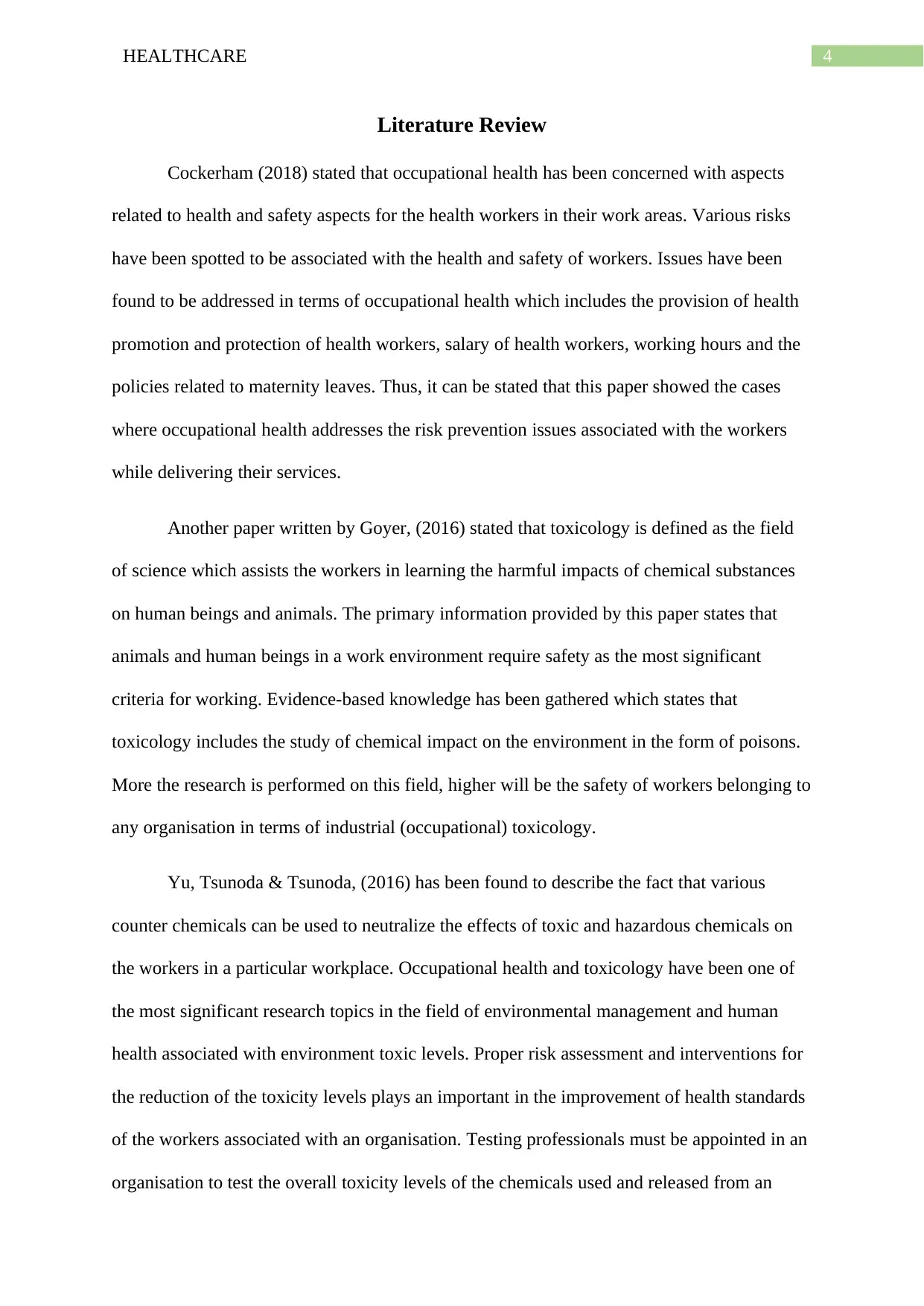
4HEALTHCARE
Literature Review
Cockerham (2018) stated that occupational health has been concerned with aspects
related to health and safety aspects for the health workers in their work areas. Various risks
have been spotted to be associated with the health and safety of workers. Issues have been
found to be addressed in terms of occupational health which includes the provision of health
promotion and protection of health workers, salary of health workers, working hours and the
policies related to maternity leaves. Thus, it can be stated that this paper showed the cases
where occupational health addresses the risk prevention issues associated with the workers
while delivering their services.
Another paper written by Goyer, (2016) stated that toxicology is defined as the field
of science which assists the workers in learning the harmful impacts of chemical substances
on human beings and animals. The primary information provided by this paper states that
animals and human beings in a work environment require safety as the most significant
criteria for working. Evidence-based knowledge has been gathered which states that
toxicology includes the study of chemical impact on the environment in the form of poisons.
More the research is performed on this field, higher will be the safety of workers belonging to
any organisation in terms of industrial (occupational) toxicology.
Yu, Tsunoda & Tsunoda, (2016) has been found to describe the fact that various
counter chemicals can be used to neutralize the effects of toxic and hazardous chemicals on
the workers in a particular workplace. Occupational health and toxicology have been one of
the most significant research topics in the field of environmental management and human
health associated with environment toxic levels. Proper risk assessment and interventions for
the reduction of the toxicity levels plays an important in the improvement of health standards
of the workers associated with an organisation. Testing professionals must be appointed in an
organisation to test the overall toxicity levels of the chemicals used and released from an
Literature Review
Cockerham (2018) stated that occupational health has been concerned with aspects
related to health and safety aspects for the health workers in their work areas. Various risks
have been spotted to be associated with the health and safety of workers. Issues have been
found to be addressed in terms of occupational health which includes the provision of health
promotion and protection of health workers, salary of health workers, working hours and the
policies related to maternity leaves. Thus, it can be stated that this paper showed the cases
where occupational health addresses the risk prevention issues associated with the workers
while delivering their services.
Another paper written by Goyer, (2016) stated that toxicology is defined as the field
of science which assists the workers in learning the harmful impacts of chemical substances
on human beings and animals. The primary information provided by this paper states that
animals and human beings in a work environment require safety as the most significant
criteria for working. Evidence-based knowledge has been gathered which states that
toxicology includes the study of chemical impact on the environment in the form of poisons.
More the research is performed on this field, higher will be the safety of workers belonging to
any organisation in terms of industrial (occupational) toxicology.
Yu, Tsunoda & Tsunoda, (2016) has been found to describe the fact that various
counter chemicals can be used to neutralize the effects of toxic and hazardous chemicals on
the workers in a particular workplace. Occupational health and toxicology have been one of
the most significant research topics in the field of environmental management and human
health associated with environment toxic levels. Proper risk assessment and interventions for
the reduction of the toxicity levels plays an important in the improvement of health standards
of the workers associated with an organisation. Testing professionals must be appointed in an
organisation to test the overall toxicity levels of the chemicals used and released from an
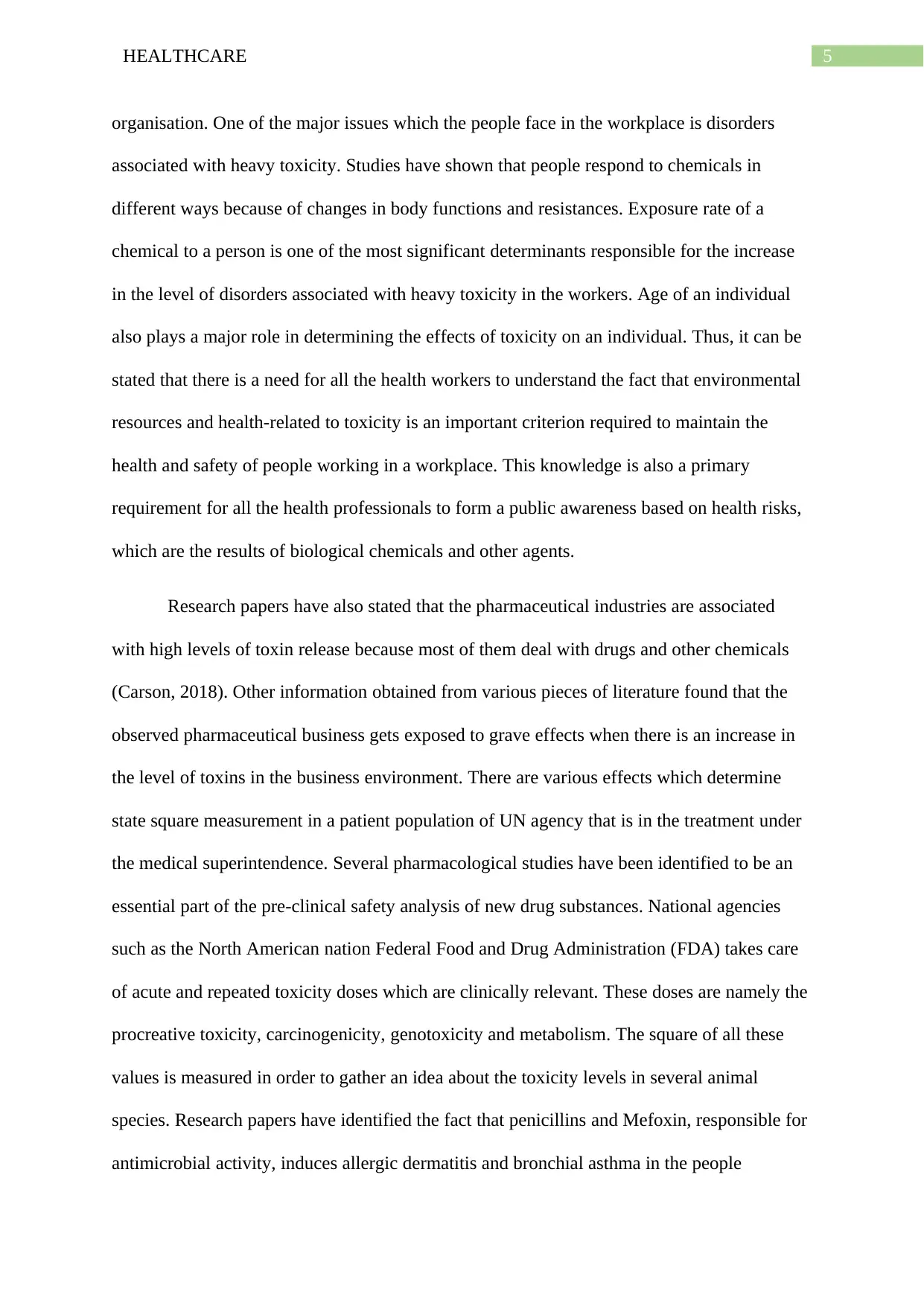
5HEALTHCARE
organisation. One of the major issues which the people face in the workplace is disorders
associated with heavy toxicity. Studies have shown that people respond to chemicals in
different ways because of changes in body functions and resistances. Exposure rate of a
chemical to a person is one of the most significant determinants responsible for the increase
in the level of disorders associated with heavy toxicity in the workers. Age of an individual
also plays a major role in determining the effects of toxicity on an individual. Thus, it can be
stated that there is a need for all the health workers to understand the fact that environmental
resources and health-related to toxicity is an important criterion required to maintain the
health and safety of people working in a workplace. This knowledge is also a primary
requirement for all the health professionals to form a public awareness based on health risks,
which are the results of biological chemicals and other agents.
Research papers have also stated that the pharmaceutical industries are associated
with high levels of toxin release because most of them deal with drugs and other chemicals
(Carson, 2018). Other information obtained from various pieces of literature found that the
observed pharmaceutical business gets exposed to grave effects when there is an increase in
the level of toxins in the business environment. There are various effects which determine
state square measurement in a patient population of UN agency that is in the treatment under
the medical superintendence. Several pharmacological studies have been identified to be an
essential part of the pre-clinical safety analysis of new drug substances. National agencies
such as the North American nation Federal Food and Drug Administration (FDA) takes care
of acute and repeated toxicity doses which are clinically relevant. These doses are namely the
procreative toxicity, carcinogenicity, genotoxicity and metabolism. The square of all these
values is measured in order to gather an idea about the toxicity levels in several animal
species. Research papers have identified the fact that penicillins and Mefoxin, responsible for
antimicrobial activity, induces allergic dermatitis and bronchial asthma in the people
organisation. One of the major issues which the people face in the workplace is disorders
associated with heavy toxicity. Studies have shown that people respond to chemicals in
different ways because of changes in body functions and resistances. Exposure rate of a
chemical to a person is one of the most significant determinants responsible for the increase
in the level of disorders associated with heavy toxicity in the workers. Age of an individual
also plays a major role in determining the effects of toxicity on an individual. Thus, it can be
stated that there is a need for all the health workers to understand the fact that environmental
resources and health-related to toxicity is an important criterion required to maintain the
health and safety of people working in a workplace. This knowledge is also a primary
requirement for all the health professionals to form a public awareness based on health risks,
which are the results of biological chemicals and other agents.
Research papers have also stated that the pharmaceutical industries are associated
with high levels of toxin release because most of them deal with drugs and other chemicals
(Carson, 2018). Other information obtained from various pieces of literature found that the
observed pharmaceutical business gets exposed to grave effects when there is an increase in
the level of toxins in the business environment. There are various effects which determine
state square measurement in a patient population of UN agency that is in the treatment under
the medical superintendence. Several pharmacological studies have been identified to be an
essential part of the pre-clinical safety analysis of new drug substances. National agencies
such as the North American nation Federal Food and Drug Administration (FDA) takes care
of acute and repeated toxicity doses which are clinically relevant. These doses are namely the
procreative toxicity, carcinogenicity, genotoxicity and metabolism. The square of all these
values is measured in order to gather an idea about the toxicity levels in several animal
species. Research papers have identified the fact that penicillins and Mefoxin, responsible for
antimicrobial activity, induces allergic dermatitis and bronchial asthma in the people
⊘ This is a preview!⊘
Do you want full access?
Subscribe today to unlock all pages.

Trusted by 1+ million students worldwide
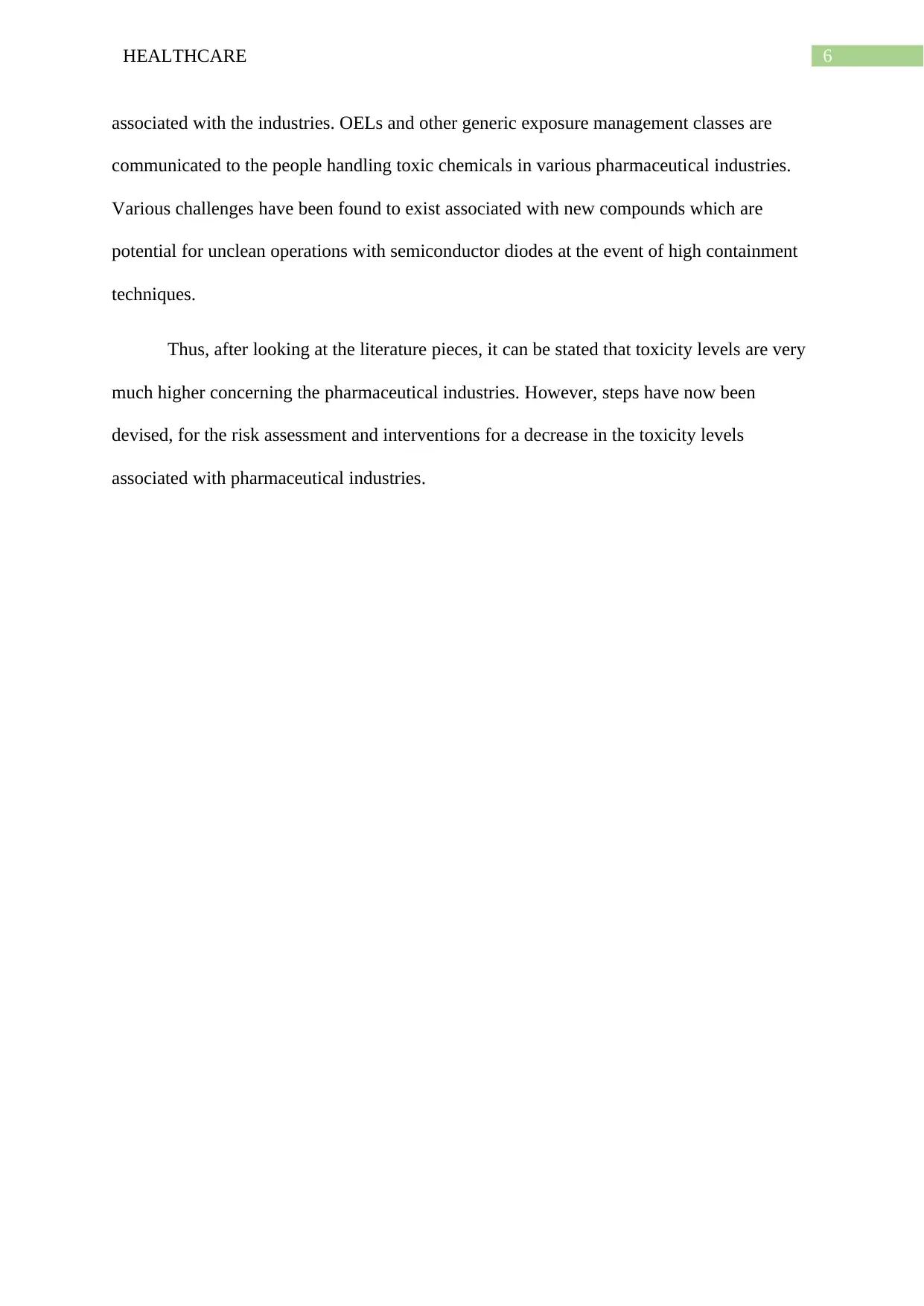
6HEALTHCARE
associated with the industries. OELs and other generic exposure management classes are
communicated to the people handling toxic chemicals in various pharmaceutical industries.
Various challenges have been found to exist associated with new compounds which are
potential for unclean operations with semiconductor diodes at the event of high containment
techniques.
Thus, after looking at the literature pieces, it can be stated that toxicity levels are very
much higher concerning the pharmaceutical industries. However, steps have now been
devised, for the risk assessment and interventions for a decrease in the toxicity levels
associated with pharmaceutical industries.
associated with the industries. OELs and other generic exposure management classes are
communicated to the people handling toxic chemicals in various pharmaceutical industries.
Various challenges have been found to exist associated with new compounds which are
potential for unclean operations with semiconductor diodes at the event of high containment
techniques.
Thus, after looking at the literature pieces, it can be stated that toxicity levels are very
much higher concerning the pharmaceutical industries. However, steps have now been
devised, for the risk assessment and interventions for a decrease in the toxicity levels
associated with pharmaceutical industries.
Paraphrase This Document
Need a fresh take? Get an instant paraphrase of this document with our AI Paraphraser
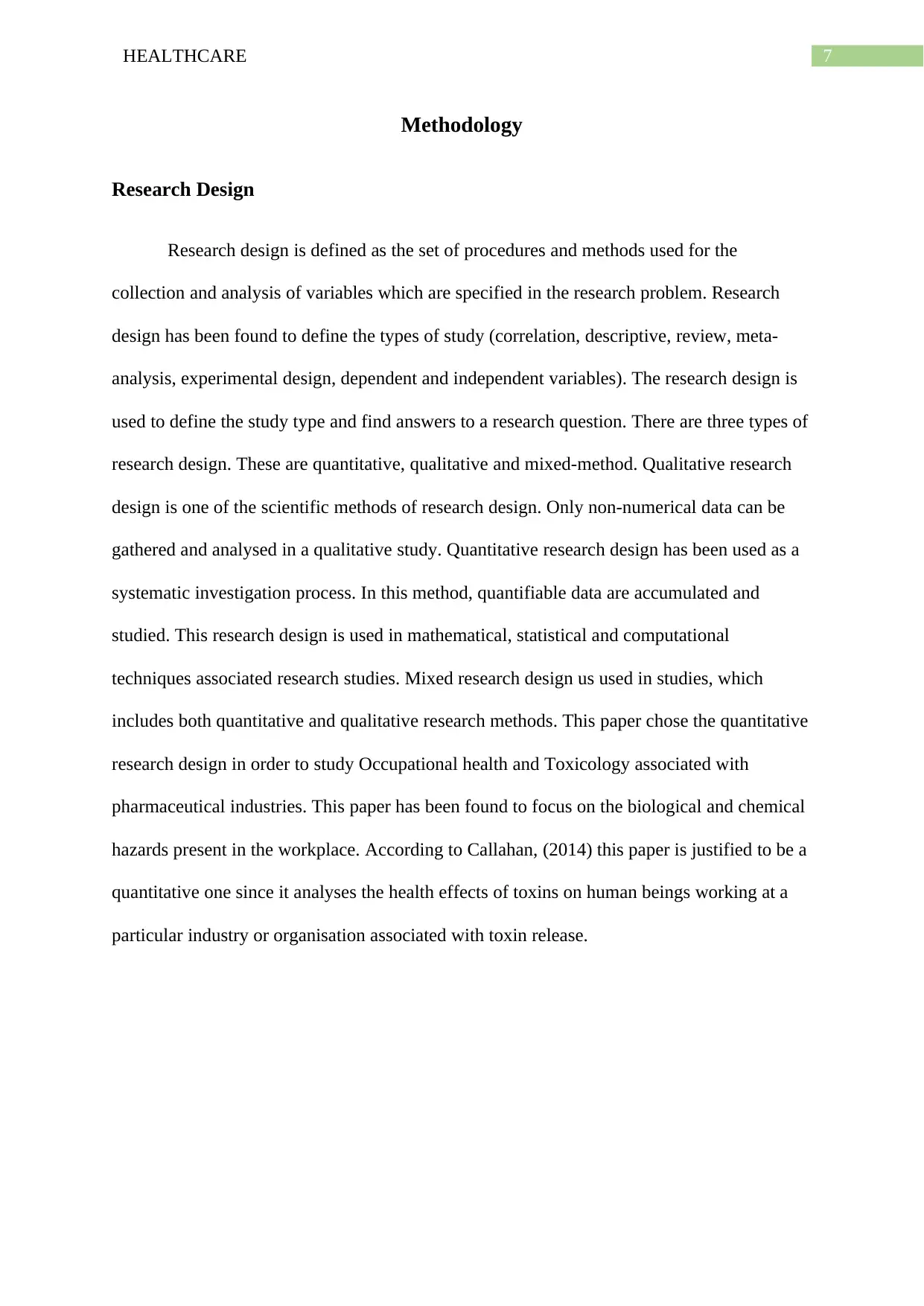
7HEALTHCARE
Methodology
Research Design
Research design is defined as the set of procedures and methods used for the
collection and analysis of variables which are specified in the research problem. Research
design has been found to define the types of study (correlation, descriptive, review, meta-
analysis, experimental design, dependent and independent variables). The research design is
used to define the study type and find answers to a research question. There are three types of
research design. These are quantitative, qualitative and mixed-method. Qualitative research
design is one of the scientific methods of research design. Only non-numerical data can be
gathered and analysed in a qualitative study. Quantitative research design has been used as a
systematic investigation process. In this method, quantifiable data are accumulated and
studied. This research design is used in mathematical, statistical and computational
techniques associated research studies. Mixed research design us used in studies, which
includes both quantitative and qualitative research methods. This paper chose the quantitative
research design in order to study Occupational health and Toxicology associated with
pharmaceutical industries. This paper has been found to focus on the biological and chemical
hazards present in the workplace. According to Callahan, (2014) this paper is justified to be a
quantitative one since it analyses the health effects of toxins on human beings working at a
particular industry or organisation associated with toxin release.
Methodology
Research Design
Research design is defined as the set of procedures and methods used for the
collection and analysis of variables which are specified in the research problem. Research
design has been found to define the types of study (correlation, descriptive, review, meta-
analysis, experimental design, dependent and independent variables). The research design is
used to define the study type and find answers to a research question. There are three types of
research design. These are quantitative, qualitative and mixed-method. Qualitative research
design is one of the scientific methods of research design. Only non-numerical data can be
gathered and analysed in a qualitative study. Quantitative research design has been used as a
systematic investigation process. In this method, quantifiable data are accumulated and
studied. This research design is used in mathematical, statistical and computational
techniques associated research studies. Mixed research design us used in studies, which
includes both quantitative and qualitative research methods. This paper chose the quantitative
research design in order to study Occupational health and Toxicology associated with
pharmaceutical industries. This paper has been found to focus on the biological and chemical
hazards present in the workplace. According to Callahan, (2014) this paper is justified to be a
quantitative one since it analyses the health effects of toxins on human beings working at a
particular industry or organisation associated with toxin release.
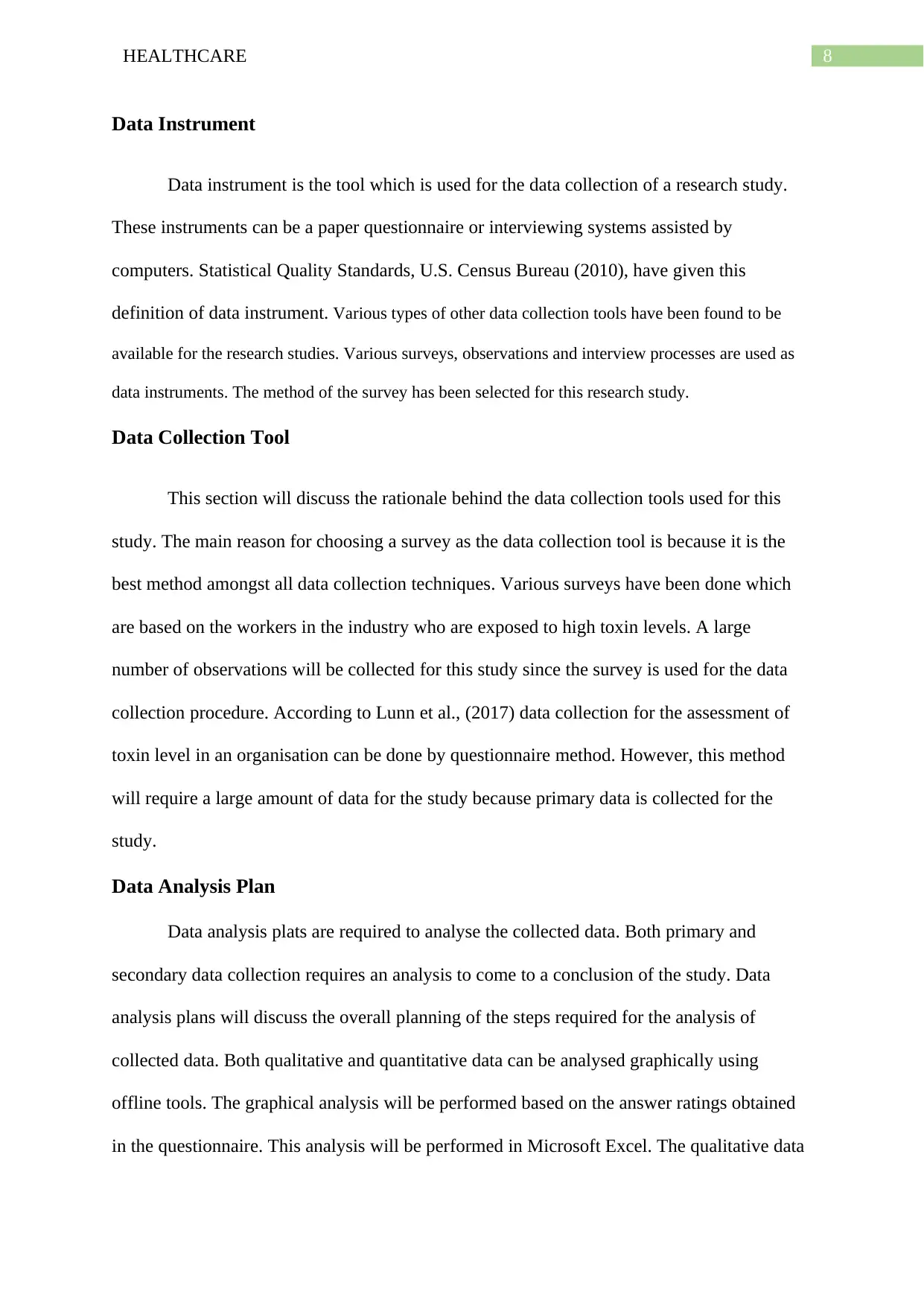
8HEALTHCARE
Data Instrument
Data instrument is the tool which is used for the data collection of a research study.
These instruments can be a paper questionnaire or interviewing systems assisted by
computers. Statistical Quality Standards, U.S. Census Bureau (2010), have given this
definition of data instrument. Various types of other data collection tools have been found to be
available for the research studies. Various surveys, observations and interview processes are used as
data instruments. The method of the survey has been selected for this research study.
Data Collection Tool
This section will discuss the rationale behind the data collection tools used for this
study. The main reason for choosing a survey as the data collection tool is because it is the
best method amongst all data collection techniques. Various surveys have been done which
are based on the workers in the industry who are exposed to high toxin levels. A large
number of observations will be collected for this study since the survey is used for the data
collection procedure. According to Lunn et al., (2017) data collection for the assessment of
toxin level in an organisation can be done by questionnaire method. However, this method
will require a large amount of data for the study because primary data is collected for the
study.
Data Analysis Plan
Data analysis plats are required to analyse the collected data. Both primary and
secondary data collection requires an analysis to come to a conclusion of the study. Data
analysis plans will discuss the overall planning of the steps required for the analysis of
collected data. Both qualitative and quantitative data can be analysed graphically using
offline tools. The graphical analysis will be performed based on the answer ratings obtained
in the questionnaire. This analysis will be performed in Microsoft Excel. The qualitative data
Data Instrument
Data instrument is the tool which is used for the data collection of a research study.
These instruments can be a paper questionnaire or interviewing systems assisted by
computers. Statistical Quality Standards, U.S. Census Bureau (2010), have given this
definition of data instrument. Various types of other data collection tools have been found to be
available for the research studies. Various surveys, observations and interview processes are used as
data instruments. The method of the survey has been selected for this research study.
Data Collection Tool
This section will discuss the rationale behind the data collection tools used for this
study. The main reason for choosing a survey as the data collection tool is because it is the
best method amongst all data collection techniques. Various surveys have been done which
are based on the workers in the industry who are exposed to high toxin levels. A large
number of observations will be collected for this study since the survey is used for the data
collection procedure. According to Lunn et al., (2017) data collection for the assessment of
toxin level in an organisation can be done by questionnaire method. However, this method
will require a large amount of data for the study because primary data is collected for the
study.
Data Analysis Plan
Data analysis plats are required to analyse the collected data. Both primary and
secondary data collection requires an analysis to come to a conclusion of the study. Data
analysis plans will discuss the overall planning of the steps required for the analysis of
collected data. Both qualitative and quantitative data can be analysed graphically using
offline tools. The graphical analysis will be performed based on the answer ratings obtained
in the questionnaire. This analysis will be performed in Microsoft Excel. The qualitative data
⊘ This is a preview!⊘
Do you want full access?
Subscribe today to unlock all pages.

Trusted by 1+ million students worldwide
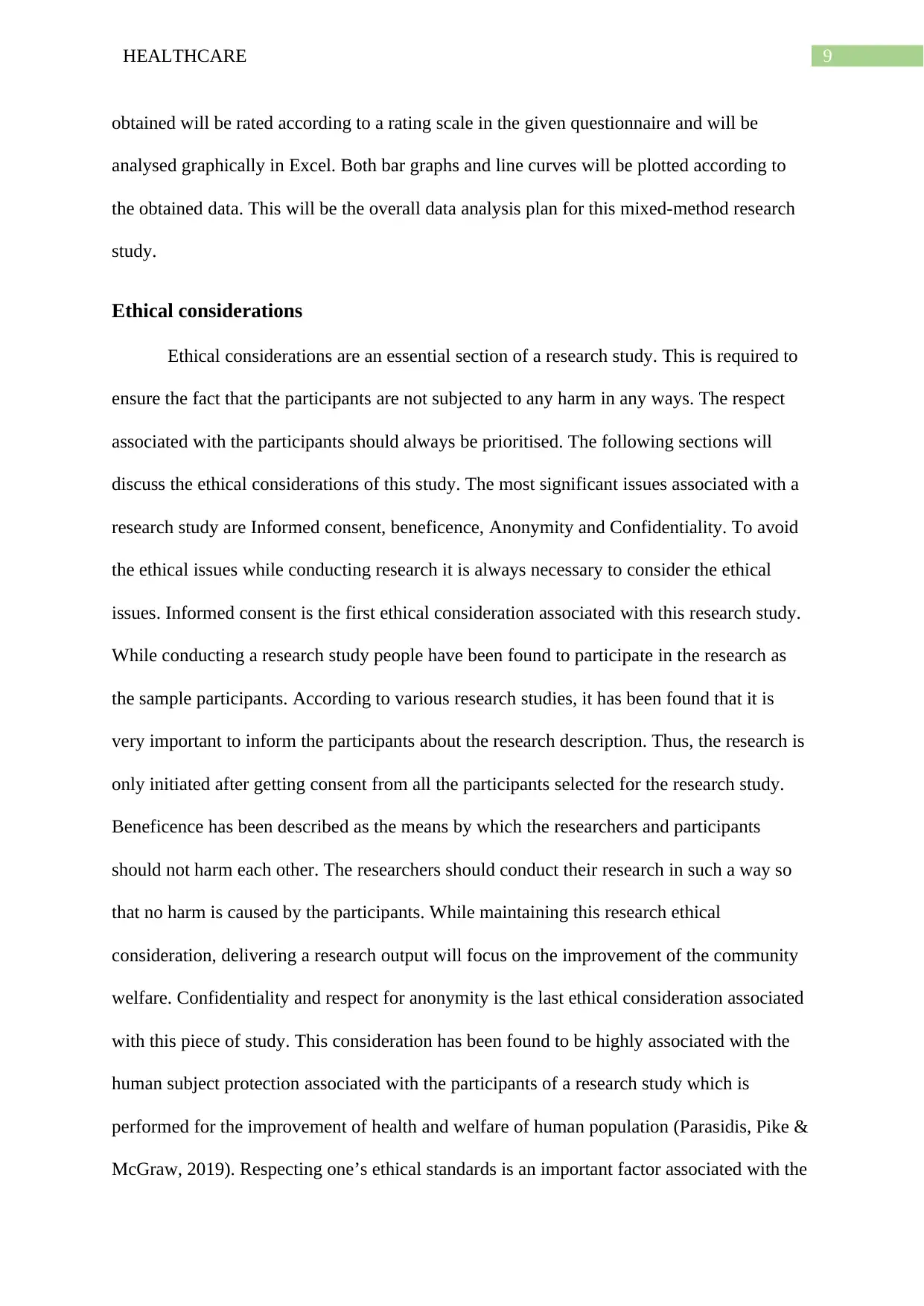
9HEALTHCARE
obtained will be rated according to a rating scale in the given questionnaire and will be
analysed graphically in Excel. Both bar graphs and line curves will be plotted according to
the obtained data. This will be the overall data analysis plan for this mixed-method research
study.
Ethical considerations
Ethical considerations are an essential section of a research study. This is required to
ensure the fact that the participants are not subjected to any harm in any ways. The respect
associated with the participants should always be prioritised. The following sections will
discuss the ethical considerations of this study. The most significant issues associated with a
research study are Informed consent, beneficence, Anonymity and Confidentiality. To avoid
the ethical issues while conducting research it is always necessary to consider the ethical
issues. Informed consent is the first ethical consideration associated with this research study.
While conducting a research study people have been found to participate in the research as
the sample participants. According to various research studies, it has been found that it is
very important to inform the participants about the research description. Thus, the research is
only initiated after getting consent from all the participants selected for the research study.
Beneficence has been described as the means by which the researchers and participants
should not harm each other. The researchers should conduct their research in such a way so
that no harm is caused by the participants. While maintaining this research ethical
consideration, delivering a research output will focus on the improvement of the community
welfare. Confidentiality and respect for anonymity is the last ethical consideration associated
with this piece of study. This consideration has been found to be highly associated with the
human subject protection associated with the participants of a research study which is
performed for the improvement of health and welfare of human population (Parasidis, Pike &
McGraw, 2019). Respecting one’s ethical standards is an important factor associated with the
obtained will be rated according to a rating scale in the given questionnaire and will be
analysed graphically in Excel. Both bar graphs and line curves will be plotted according to
the obtained data. This will be the overall data analysis plan for this mixed-method research
study.
Ethical considerations
Ethical considerations are an essential section of a research study. This is required to
ensure the fact that the participants are not subjected to any harm in any ways. The respect
associated with the participants should always be prioritised. The following sections will
discuss the ethical considerations of this study. The most significant issues associated with a
research study are Informed consent, beneficence, Anonymity and Confidentiality. To avoid
the ethical issues while conducting research it is always necessary to consider the ethical
issues. Informed consent is the first ethical consideration associated with this research study.
While conducting a research study people have been found to participate in the research as
the sample participants. According to various research studies, it has been found that it is
very important to inform the participants about the research description. Thus, the research is
only initiated after getting consent from all the participants selected for the research study.
Beneficence has been described as the means by which the researchers and participants
should not harm each other. The researchers should conduct their research in such a way so
that no harm is caused by the participants. While maintaining this research ethical
consideration, delivering a research output will focus on the improvement of the community
welfare. Confidentiality and respect for anonymity is the last ethical consideration associated
with this piece of study. This consideration has been found to be highly associated with the
human subject protection associated with the participants of a research study which is
performed for the improvement of health and welfare of human population (Parasidis, Pike &
McGraw, 2019). Respecting one’s ethical standards is an important factor associated with the
Paraphrase This Document
Need a fresh take? Get an instant paraphrase of this document with our AI Paraphraser
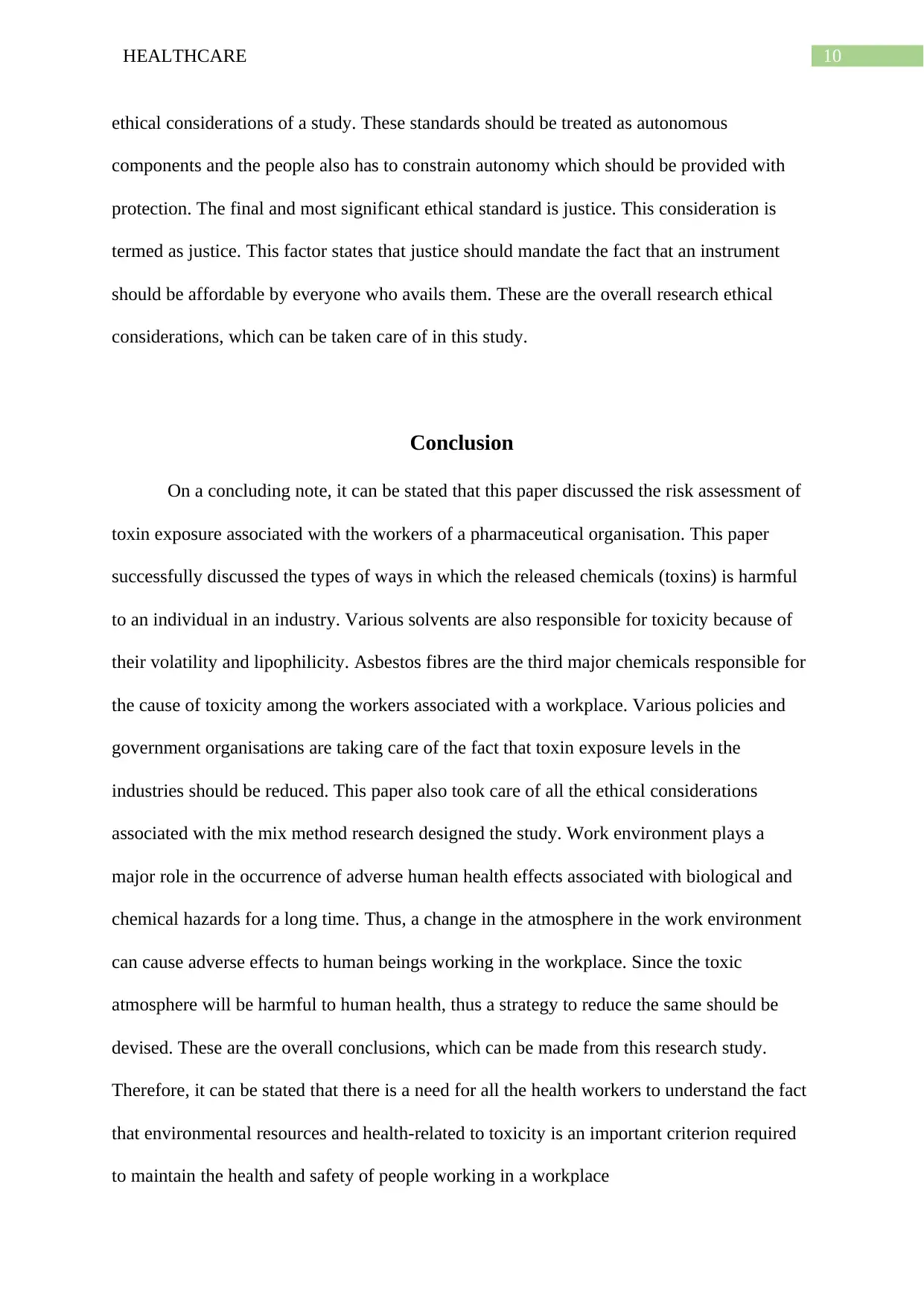
10HEALTHCARE
ethical considerations of a study. These standards should be treated as autonomous
components and the people also has to constrain autonomy which should be provided with
protection. The final and most significant ethical standard is justice. This consideration is
termed as justice. This factor states that justice should mandate the fact that an instrument
should be affordable by everyone who avails them. These are the overall research ethical
considerations, which can be taken care of in this study.
Conclusion
On a concluding note, it can be stated that this paper discussed the risk assessment of
toxin exposure associated with the workers of a pharmaceutical organisation. This paper
successfully discussed the types of ways in which the released chemicals (toxins) is harmful
to an individual in an industry. Various solvents are also responsible for toxicity because of
their volatility and lipophilicity. Asbestos fibres are the third major chemicals responsible for
the cause of toxicity among the workers associated with a workplace. Various policies and
government organisations are taking care of the fact that toxin exposure levels in the
industries should be reduced. This paper also took care of all the ethical considerations
associated with the mix method research designed the study. Work environment plays a
major role in the occurrence of adverse human health effects associated with biological and
chemical hazards for a long time. Thus, a change in the atmosphere in the work environment
can cause adverse effects to human beings working in the workplace. Since the toxic
atmosphere will be harmful to human health, thus a strategy to reduce the same should be
devised. These are the overall conclusions, which can be made from this research study.
Therefore, it can be stated that there is a need for all the health workers to understand the fact
that environmental resources and health-related to toxicity is an important criterion required
to maintain the health and safety of people working in a workplace
ethical considerations of a study. These standards should be treated as autonomous
components and the people also has to constrain autonomy which should be provided with
protection. The final and most significant ethical standard is justice. This consideration is
termed as justice. This factor states that justice should mandate the fact that an instrument
should be affordable by everyone who avails them. These are the overall research ethical
considerations, which can be taken care of in this study.
Conclusion
On a concluding note, it can be stated that this paper discussed the risk assessment of
toxin exposure associated with the workers of a pharmaceutical organisation. This paper
successfully discussed the types of ways in which the released chemicals (toxins) is harmful
to an individual in an industry. Various solvents are also responsible for toxicity because of
their volatility and lipophilicity. Asbestos fibres are the third major chemicals responsible for
the cause of toxicity among the workers associated with a workplace. Various policies and
government organisations are taking care of the fact that toxin exposure levels in the
industries should be reduced. This paper also took care of all the ethical considerations
associated with the mix method research designed the study. Work environment plays a
major role in the occurrence of adverse human health effects associated with biological and
chemical hazards for a long time. Thus, a change in the atmosphere in the work environment
can cause adverse effects to human beings working in the workplace. Since the toxic
atmosphere will be harmful to human health, thus a strategy to reduce the same should be
devised. These are the overall conclusions, which can be made from this research study.
Therefore, it can be stated that there is a need for all the health workers to understand the fact
that environmental resources and health-related to toxicity is an important criterion required
to maintain the health and safety of people working in a workplace

11HEALTHCARE
⊘ This is a preview!⊘
Do you want full access?
Subscribe today to unlock all pages.

Trusted by 1+ million students worldwide
1 out of 13
Related Documents
Your All-in-One AI-Powered Toolkit for Academic Success.
+13062052269
info@desklib.com
Available 24*7 on WhatsApp / Email
![[object Object]](/_next/static/media/star-bottom.7253800d.svg)
Unlock your academic potential
Copyright © 2020–2025 A2Z Services. All Rights Reserved. Developed and managed by ZUCOL.





